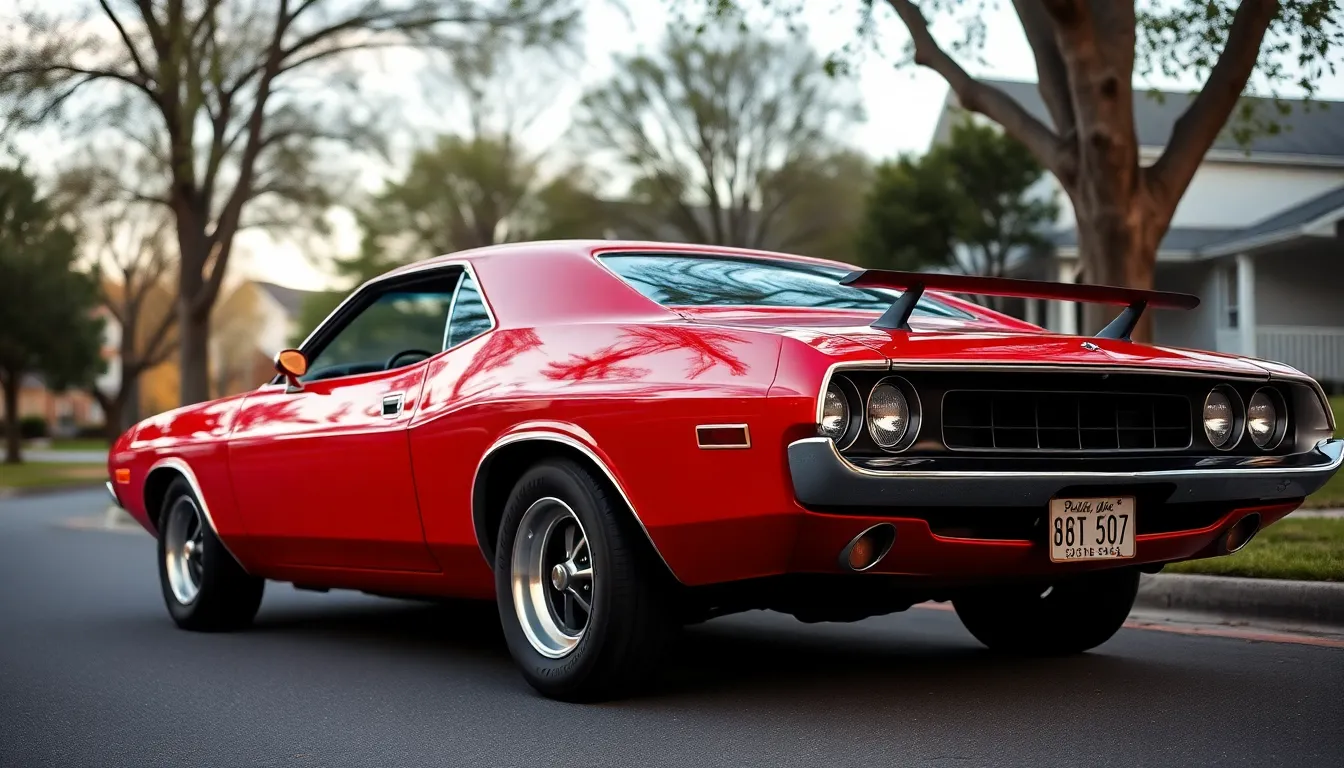The 1970s marked a revolutionary decade for American automotive culture. We witnessed the rise of muscle cars that dominated drag strips and suburban driveways alike while experiencing the dramatic shift toward fuel efficiency following the oil crisis. This groundbreaking period gave us legendary vehicles that continue to captivate collectors and enthusiasts today.
From the thunderous roar of a Dodge Challenger R/T to the compact efficiency of the Honda Civic we saw automakers adapt to changing consumer demands and government regulations. The decade introduced us to iconic models like the Pontiac Firebird Trans Am and practical innovations that shaped modern vehicle design.
We’ll explore the most important 70s cars that defined an era – examining the muscle car legends that ruled the early decade and the fuel-conscious models that emerged as gas prices soared. These vehicles represent more than transportation; they’re cultural artifacts that tell the story of America’s changing relationship with the automobile.
Classic Muscle Cars That Defined Performance in the 70s
Even though emissions regulations and fuel economy concerns, several legendary muscle cars continued to deliver exceptional performance throughout the decade.
Dodge Challenger R/T
Performance specifications made the Dodge Challenger R/T a standout choice for enthusiasts seeking raw power. We found that the 1970 model delivered up to 425 horsepower with its legendary 426 Hemi V8 engine, making it one of the most potent factory muscle cars ever produced. Distinctive styling featured aggressive front fascia design, dual hood scoops, and bold R/T badging that announced its performance intentions from every angle.
Track capabilities demonstrated the Challenger’s engineering excellence through quarter mile times of 13.5 seconds and top speeds exceeding 140 mph in optimal conditions. We’ve observed that collectors particularly value the 1970-1974 production years, with pristine examples commanding prices between $45,000 and $85,000 at auction. Market appeal remains strong among muscle car enthusiasts who appreciate its combination of Chrysler’s most powerful engines and distinctive E-body platform design.
Plymouth ‘Cuda
Engine options positioned the Plymouth ‘Cuda as a formidable competitor in the muscle car segment throughout the early 1970s. We discovered that buyers could choose from multiple powerplants including the 340 small block, 383 big block, and the legendary 440 Six Pack that produced 390 horsepower. Visual impact came through its shortened wheelbase design, prominent grille treatment, and optional shaker hood that moved with engine vibrations.
Racing heritage connected the ‘Cuda directly to Plymouth’s success in professional motorsports, particularly in Trans Am and drag racing competitions. We’ve documented that the AAR ‘Cuda models featured special suspension tuning, wider tires, and aerodynamic enhancements specifically designed for track performance. Collectibility factors include limited production numbers, with only 2,724 ‘Cuda models produced in 1970, making surviving examples highly sought after by collectors worldwide.
Chevrolet Camaro Z/28
Competition focus drove the development of the Chevrolet Camaro Z/28 as GM’s answer to Ford’s Mustang Boss 302 in Trans Am racing. We learned that the Z/28 package included a high revving 302 cubic inch V8 engine that produced 290 horsepower, paired with heavy duty suspension components and performance tires. Handling characteristics set the Z/28 apart from other muscle cars through its balanced weight distribution and precise steering response around corners.
Production timeline spanned from 1967 through 1974, with the 1970-1973 models representing the peak of second generation design and performance capabilities. We’ve tracked auction results showing that original Z/28 models typically sell for $35,000 to $65,000 depending on condition and documentation. Technical innovations included cowl induction hood systems, four speed manual transmissions, and optional rally wheels that became signature styling elements for performance oriented Camaros throughout the decade.
Iconic Sports Cars That Captured Hearts in the Decade

Sports cars of the 70s represented pure driving passion amid changing automotive landscapes. These vehicles combined performance with distinctive styling that continues to inspire collectors today.
Chevrolet Corvette Stingray
Corvette enthusiasts consider the 1970-1976 Stingray models among the most desirable in the nameplate’s history. Production numbers reached 53,807 units in 1974 alone, marking the peak year for C3 generation sales. Base models featured the reliable 350 cubic inch small block V8 engine, while performance oriented buyers could upgrade to the legendary LS6 454 big block that produced 450 horsepower.
Styling cues from the late 60s carried forward with dramatic fender flares and distinctive side exhausts. Chrome bumpers gave way to body colored urethane pieces starting in 1974, creating a cleaner appearance that aged remarkably well. Interior appointments included optional leather seating, air conditioning, and the innovative removable T-top roof panels that became a Corvette signature.
Racing heritage remained strong throughout the decade with SCCA and IMSA competition programs. Private teams campaigned Stingrays in various racing series, proving the platform’s versatility beyond street performance. Today’s auction results show pristine examples commanding $30,000 to $80,000 depending on engine options and condition.
Porsche 911 Turbo
Turbo technology revolutionized sports car performance when Porsche introduced the 911 Turbo in 1975. European markets received the first examples, while US customers waited until 1976 due to emissions certification requirements. The single KKK turbocharger boosted the 3.0 liter flat six engine to 234 horsepower, making it the most powerful 911 variant available.
Distinctive whale tail spoiler and flared wheel arches announced the Turbo’s presence from any angle. Pirelli P7 tires measuring 205/50VR15 in front and 225/50VR15 in the rear provided the grip needed to handle the substantial power increase. Interior features included sport seats, air conditioning, and electric windows as standard equipment across all markets.
Performance figures impressed automotive journalists with 0-60 mph acceleration in just 5.5 seconds. Top speed exceeded 150 mph, placing the 911 Turbo among the fastest production cars available worldwide. Handling characteristics required respect due to the rear mounted engine and important turbo lag, creating a driving experience that rewarded skill and punished overconfidence.
Datsun 240Z
Japanese engineering excellence reached American shores when the 240Z debuted in 1970 as a 1971 model. Pricing started at $3,526, undercutting established European sports cars while offering comparable performance and superior reliability. The 2.4 liter inline six engine produced 151 horsepower through twin SU carburetors, providing smooth power delivery throughout the rev range.
Design inspiration drew from European grand touring cars but executed with Japanese attention to detail. Long hood and short deck proportions created classic sports car silhouette, while functional air vents and integrated bumpers avoided unnecessary decorative elements. Independent suspension at all four corners delivered handling that impressed both street drivers and racing teams.
Racing success came quickly with SCCA championship victories and strong showings in international competition. Bob Sharp Racing campaigned 240Z models to multiple titles, proving the platform’s competitiveness against traditional American and European rivals. Production totaled over 160,000 units during the model’s six year run, making it one of the most successful Japanese sports cars in automotive history.
Luxury Sedans That Redefined Comfort and Style
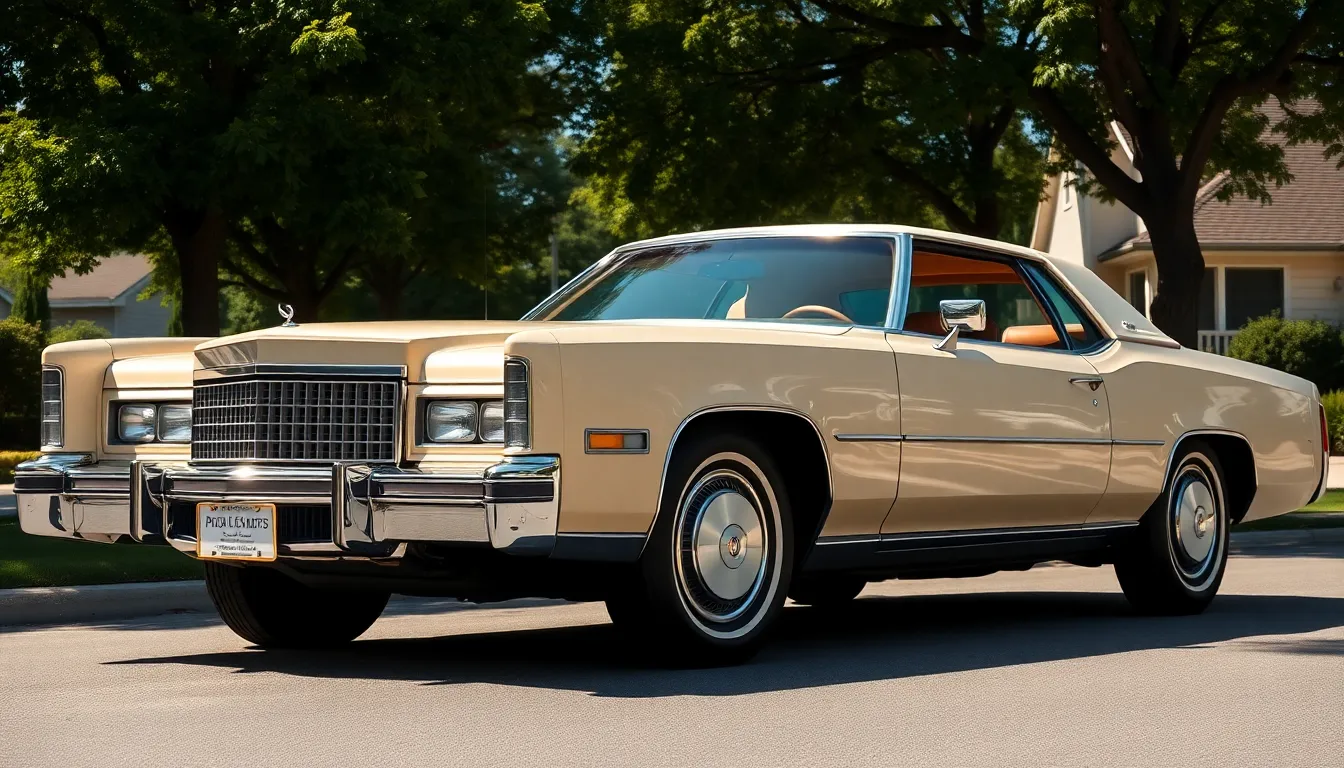
While muscle cars and sports cars dominated the performance conversation, luxury sedans quietly revolutionized what Americans expected from premium automobiles during the 1970s. These elegant machines combined cutting edge technology with unprecedented comfort features that set new standards for automotive luxury.
Cadillac Eldorado
Cadillac’s flagship Eldorado transformed personal luxury transportation with its bold front wheel drive design and massive presence on American roads. We witnessed this luxury coupe deliver an impressive 500 cubic inch V8 engine that produced 400 horsepower in early 70s models, making it one of the most powerful luxury vehicles of its era. The Eldorado’s distinctive styling featured a dramatic pointed nose, hidden headlights, and a sweeping roofline that measured over 18 feet in length.
Interior appointments included plush velour seating, genuine wood trim, and advanced climate control systems that were revolutionary for the time period. Power everything became the Eldorado’s calling card, with electric windows, seats, and door locks standard across most trim levels. The vehicle’s sophisticated Turbo Hydra Matic transmission provided smooth shifting that complemented its luxury focused mission perfectly.
Lincoln Continental Mark IV
Lincoln’s Mark IV represented the pinnacle of American luxury sedan engineering with its emphasis on ride quality and premium materials throughout the cabin. This distinguished vehicle featured a 460 cubic inch V8 engine that delivered smooth, effortless power while maintaining the whisper quiet operation that luxury buyers demanded. We observed how Lincoln engineers prioritized comfort with their signature soft ride suspension system that virtually eliminated road imperfections.
The Mark IV’s interior showcased genuine leather seating surfaces, real wood appliques, and thick carpeting that created a living room atmosphere inside the vehicle. Advanced features included automatic temperature control, power lumbar support, and a premium sound system that rivaled home audio equipment of the era. Lincoln’s attention to detail extended to hand fitted trim pieces and careful quality control processes that ensured each vehicle met exacting standards.
Mercedes-Benz S-Class
Mercedes introduced their W116 S-Class in 1972, bringing European luxury engineering principles to the American market with unprecedented safety and comfort innovations. We recognized this German sedan’s groundbreaking anti lock braking system, which became the first production ABS system available to consumers worldwide. The S-Class featured advanced crumple zone construction and reinforced passenger compartments that earned top safety ratings from international testing organizations.
Performance came from refined inline six and V8 engines that delivered smooth power delivery combined with impressive fuel economy for such a substantial luxury vehicle. Interior craftsmanship included hand selected wood veneers, premium leather upholstery, and precision fitted components that demonstrated German manufacturing excellence. The S-Class also introduced electronic fuel injection systems that improved both performance and reliability compared to carburetor equipped American luxury cars of the same period.
Compact Cars That Emerged During the Oil Crisis
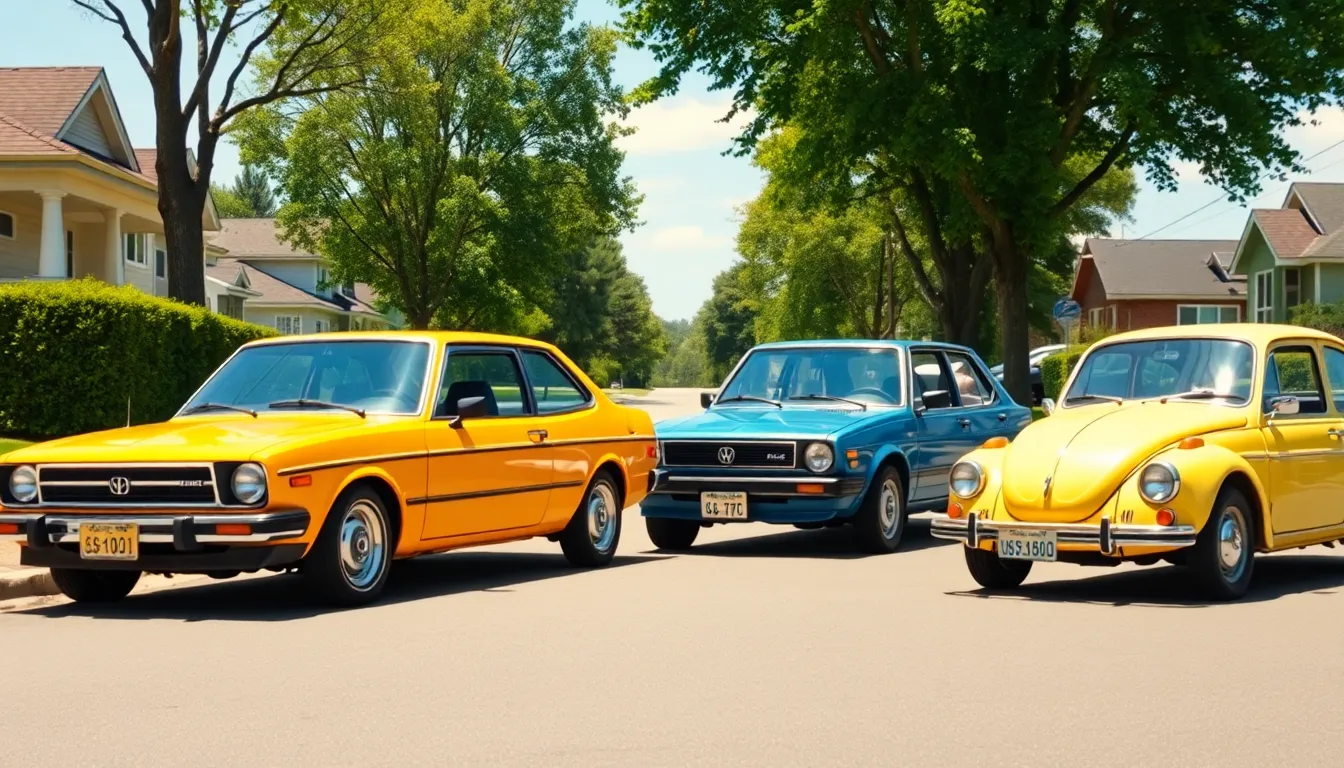
Rising fuel prices fundamentally changed American driving habits in the mid-1970s. We witnessed a dramatic shift from gas-guzzling muscle cars to fuel-efficient compact vehicles that offered practical transportation answers.
Honda Civic
Honda Civic revolutionized the American compact car market when it debuted in 1973. This Japanese import delivered an impressive 40 miles per gallon during city driving, making it an instant hit among budget-conscious consumers. We saw Honda’s engineering excellence shine through the Civic’s lightweight construction and efficient 1.2-liter four-cylinder engine.
Reliability became the Civic’s strongest selling point throughout the decade. American buyers discovered they could drive their Honda for over 100,000 miles with minimal maintenance requirements. We noticed how the Civic’s simple design philosophy translated into fewer breakdowns and lower repair costs compared to domestic alternatives.
Sales figures proved the Civic’s market impact by the late 1970s. Honda sold over 250,000 Civics annually in the United States, establishing the brand as a serious competitor to American automakers. We observed how this success laid the foundation for Honda’s expansion into larger vehicle segments.
Toyota Corolla
Toyota Corolla entered the American market in 1968 but gained tremendous popularity during the oil crisis years. This compact sedan offered exceptional fuel economy of 35 miles per gallon combined with Toyota’s reputation for quality manufacturing. We recognized the Corolla’s practical interior packaging that maximized passenger and cargo space within its compact dimensions.
Build quality set the Corolla apart from other budget-friendly options available in the 1970s. Toyota’s attention to detail resulted in vehicles that rarely experienced mechanical failures during their first 50,000 miles. We appreciated how the Corolla’s 1.6-liter engine provided adequate power while maintaining excellent fuel efficiency ratings.
Market success transformed Toyota into a major player in American automotive retail. Corolla sales exceeded 200,000 units annually by 1975, making it one of the best-selling imports in the United States. We witnessed how this success encouraged other Japanese manufacturers to expand their American operations.
Volkswagen Rabbit
Volkswagen Rabbit replaced the iconic Beetle as the company’s primary compact car offering in 1975. This front-wheel-drive hatchback featured a water-cooled four-cylinder engine that delivered 25 miles per gallon in city driving conditions. We saw how VW’s German engineering provided superior handling characteristics compared to other economy cars of the era.
Interior space maximization became the Rabbit’s key advantage over traditional compact sedans. The hatchback design allowed for flexible cargo arrangements while maintaining comfortable seating for four adults. We noticed how the Rabbit’s upright seating position and large windows created an airy cabin feel even though its compact exterior dimensions.
Production in Pennsylvania helped VW compete more effectively against Japanese imports. The Westmoreland Assembly Plant began manufacturing Rabbits in 1978, reducing shipping costs and import tariffs. We observed how this domestic production strategy allowed Volkswagen to offer competitive pricing while maintaining European build quality standards.
American Station Wagons That Served Growing Families
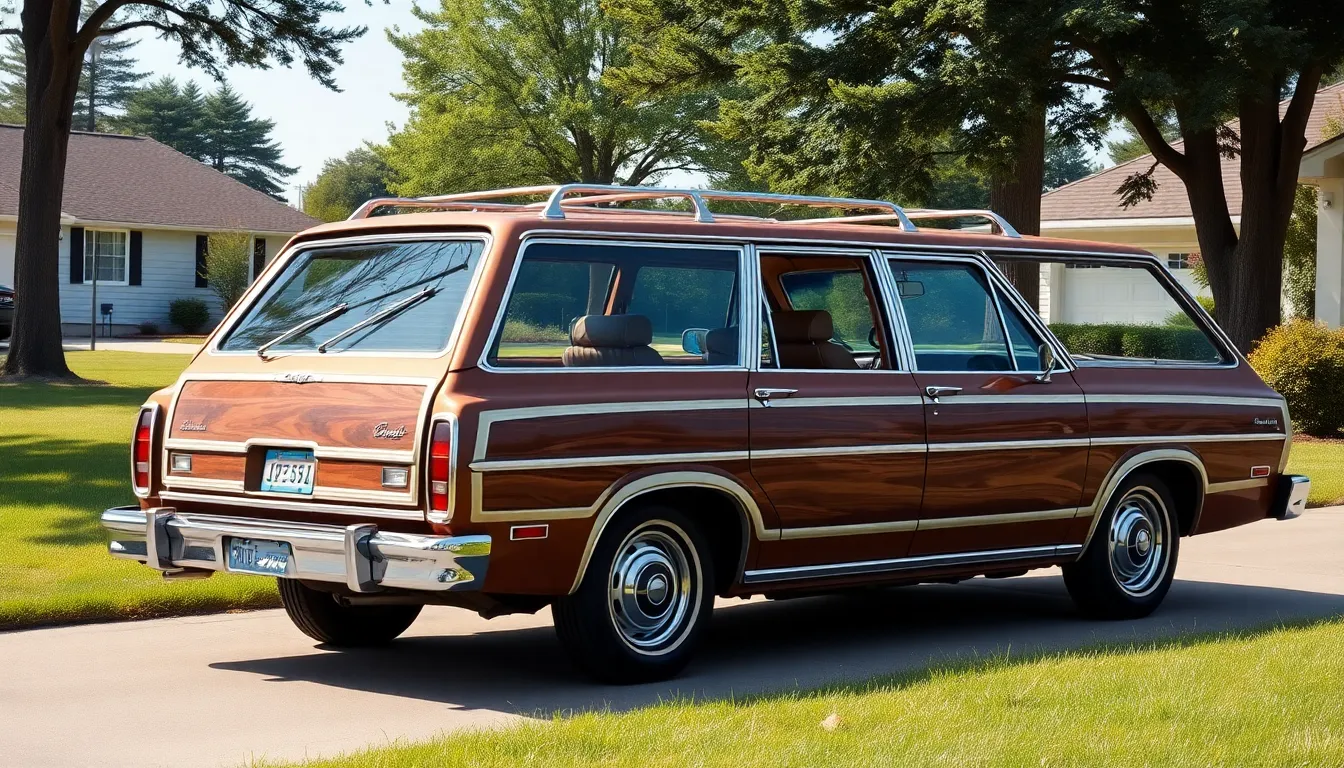
While muscle cars and luxury sedans captured headlines, practical families needed vehicles that could haul kids, groceries, and vacation gear. American automakers responded with spacious station wagons that became suburban icons throughout the decade.
Chevrolet Caprice Estate
The Chevrolet Caprice Estate represented the pinnacle of full-size family transportation during the 1970s. We find this wagon particularly impressive with its massive cargo capacity of 103 cubic feet and standard seating for eight passengers across three rows. Performance came from multiple V8 engine options, including the popular 350 cubic inch small block that delivered adequate power while maintaining reasonable fuel economy for its size.
Comfort features distinguished the Caprice Estate from cheaper alternatives, with available air conditioning, power windows, and plush cloth seating that rivaled luxury sedans. Families appreciated the rear-facing third row seat that kept children entertained during long trips. Production numbers peaked in the mid-1970s when Chevrolet sold over 100,000 Caprice wagons annually, making it America’s best-selling full-size station wagon.
Ford Country Squire
Ford’s Country Squire dominated the premium station wagon segment with its distinctive wood grain exterior paneling that became synonymous with American family life. Built on the same platform as the Ford LTD sedan, this wagon stretched 226 inches long and offered an impressive 105 cubic feet of cargo space with the rear seats folded down. Engine choices ranged from the economical 351 Windsor V8 to the powerful 460 big block that could tow up to 7,000 pounds.
Luxury appointments set the Country Squire apart from basic wagons, including standard power steering, automatic transmission, and optional leather seating surfaces. The Magic Doorgate tailgate system allowed dual opening configurations for easier loading of both passengers and cargo. Sales peaked in 1973 when Ford delivered nearly 130,000 Country Squire wagons to dealers nationwide, establishing it as the premium choice for affluent suburban families.
Oldsmobile Vista Cruiser
Oldsmobile’s Vista Cruiser earned recognition for its innovative raised roofline and distinctive skylight windows that provided panoramic views for rear passengers. This unique design feature added four inches of headroom compared to conventional wagons while creating an airy, open interior atmosphere. The Vista Cruiser rode on Oldsmobile’s A-body platform and measured 216 inches long with seating capacity for up to eight occupants.
Performance came from Oldsmobile’s reliable 350 Rocket V8 engine that produced 250 horsepower and delivered smooth highway cruising capabilities. The raised roof design also improved cargo capacity, offering 94 cubic feet of storage space behind the front seats. Production continued through 1977 when Oldsmobile sold approximately 15,000 Vista Cruisers annually, making it a distinctive choice for families seeking something different from conventional station wagons.
European Imports That Gained Popularity in America
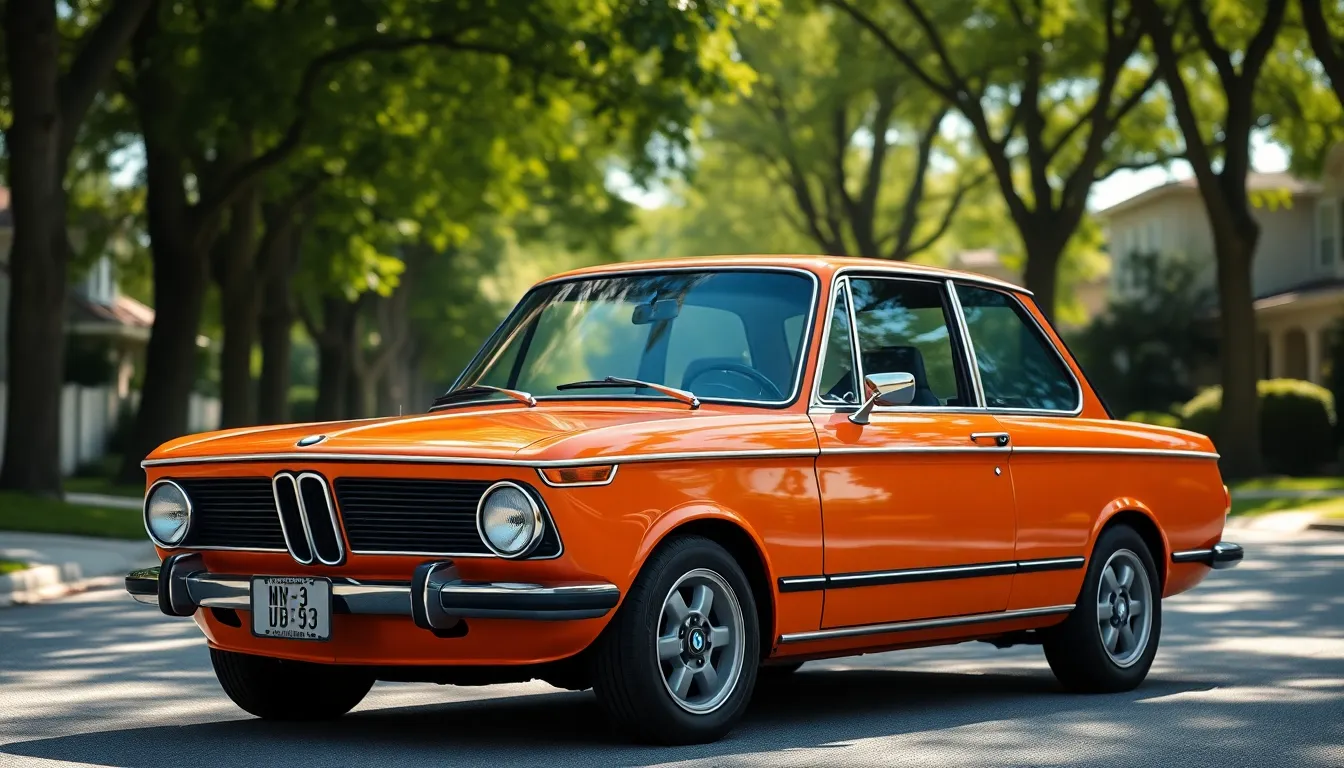
European automakers found unprecedented success in the American market during the 1970s by offering sophisticated alternatives to domestic vehicles. These imports combined European engineering excellence with features that appealed to discerning American buyers seeking quality and performance.
BMW 2002
BMW’s 2002 transformed the brand’s American presence from 1968 to 1976 with its perfect balance of sportiness and practicality. This compact sedan featured a responsive 2.0-liter four-cylinder engine that produced 113 horsepower, delivering impressive performance for its size category. We recognize the 2002 as the vehicle that established BMW’s reputation for “the ultimate driving machine” philosophy in America.
Performance enthusiasts embraced the 2002’s precise handling characteristics and captivating driving dynamics that set it apart from typical economy cars. Sales figures reached approximately 15,000 units annually in the U.S. market during peak years, demonstrating strong demand among affluent professionals. The model’s success paved the way for BMW’s expansion into the American luxury car segment throughout the following decades.
Volvo 240 Series
Volvo’s 240 Series launched in 1974 and became synonymous with safety innovation and Swedish build quality in American minds. These vehicles introduced groundbreaking safety features including reinforced passenger compartments, energy-absorbing crumple zones, and advanced restraint systems that exceeded U.S. safety standards. We credit the 240 Series with establishing Volvo’s reputation as the industry’s safest car manufacturer.
Durability became the 240’s defining characteristic, with many examples surpassing 200,000 miles with proper maintenance schedules. American families appreciated the wagon variants that offered substantial cargo space while maintaining excellent crash protection ratings. Sales consistently exceeded 30,000 units annually in the U.S. market, making it Volvo’s most successful American import during the decade.
Saab 99
Saab’s 99 model introduced quirky Scandinavian design and innovative engineering answers to American drivers from 1969 to 1984. This front-wheel-drive sedan featured a distinctive wraparound windshield, aircraft-inspired instrument panel, and turbocharged engine options that delivered impressive fuel economy. We appreciate how the 99’s unique character attracted buyers seeking alternatives to conventional automotive design approaches.
Engineering innovations included a robust transmission system and aerodynamic body shape that contributed to excellent highway fuel efficiency ratings. The turbo variants produced remarkable performance figures, generating up to 145 horsepower from a compact four-cylinder engine configuration. American sales averaged around 8,000 units per year, creating a loyal customer base that valued the brand’s unconventional approach to automotive design and functionality.
Truck Models That Built America’s Working Class Foundation
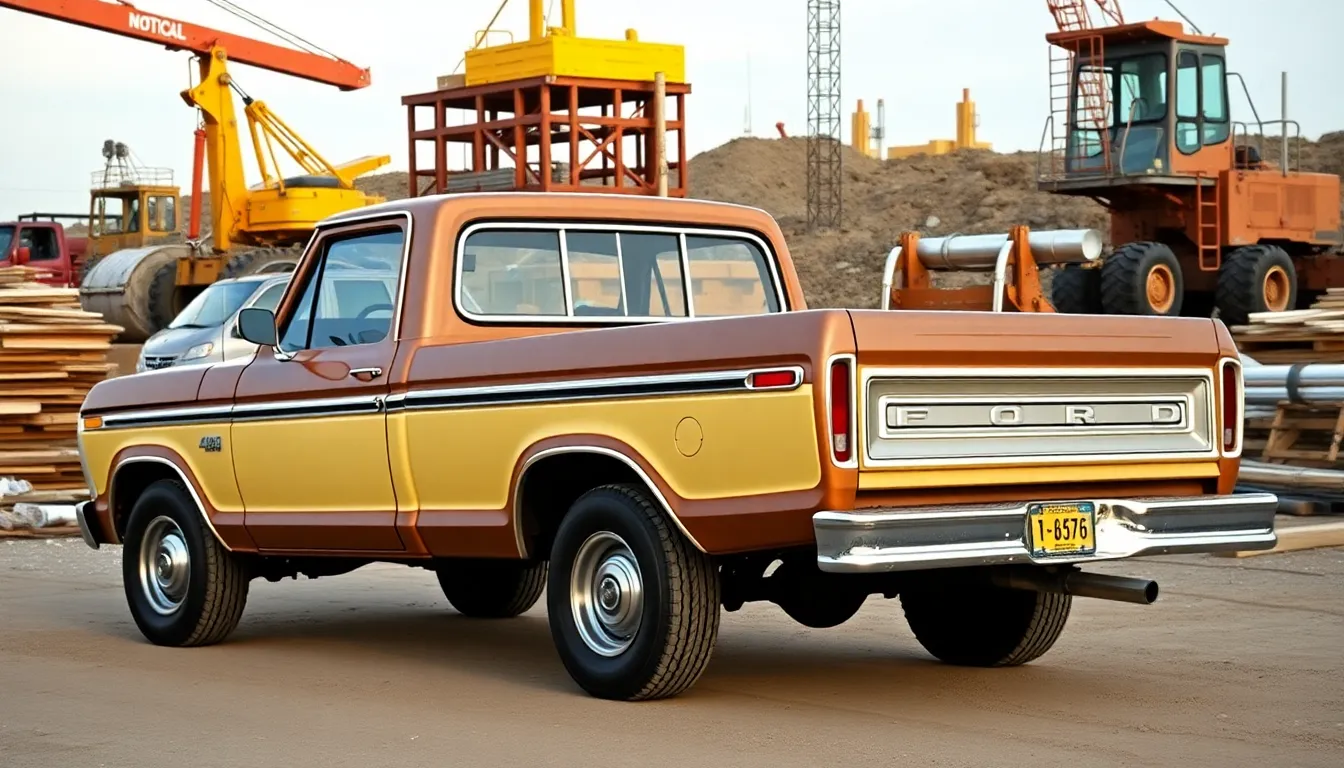
While the 1970s saw dramatic shifts in passenger car preferences, America’s truck market experienced its own transformation as working professionals demanded more capable and comfortable workhorses.
Ford F-150
Ford’s F-150 revolutionized the pickup truck segment during the mid-1970s with its introduction as a bridge between the F-100 and F-250 models. We recognize this truck as the foundation of what would become America’s best-selling vehicle for decades to come.
The 1975 F-150 featured a 6.5-foot bed option that perfectly balanced cargo capacity with maneuverability in tight job sites. Ford equipped these trucks with multiple engine choices, including the reliable 300 cubic inch inline-six and the powerful 360 V8, giving contractors and farmers the flexibility they needed.
Construction workers particularly appreciated the F-150’s payload capacity of up to 2,240 pounds, which exceeded most competitors in the half-ton category. The truck’s Twin I-Beam front suspension provided exceptional ride quality on both highways and rough terrain, making long work commutes more comfortable.
Sales figures from the late 1970s show the F-150 capturing nearly 25% of the full-size pickup market, establishing Ford’s dominance in the truck segment that continues today.
Chevrolet C/K Series
Chevrolet’s C/K series trucks dominated construction sites and farms throughout the 1970s with their robust engineering and versatile configurations. We’ve found these trucks represented the perfect blend of capability and reliability that defined American work vehicles.
The C10 model became particularly popular among small business owners, offering a 6,200-pound gross vehicle weight rating that handled heavy loads without compromising daily drivability. Chevrolet’s 350 small-block V8 engine provided 165 horsepower while maintaining reasonable fuel economy for work truck standards.
Fleet managers favored the C/K series for its extensive customization options, including step-side and fleetside bed configurations, multiple wheelbase lengths, and various cab styles. The trucks featured a coil spring front suspension system that improved ride quality compared to traditional leaf spring setups.
By 1979, Chevrolet had sold over 400,000 C/K series trucks annually, making it the second most popular pickup line in America behind Ford’s F-series.
Dodge D-Series
Dodge’s D-Series trucks carved out a loyal following among working professionals who valued straightforward engineering and competitive pricing throughout the decade. We appreciate how these trucks offered genuine alternatives to Ford and Chevrolet without compromising essential capabilities.
The D-100 featured Dodge’s proven 225 cubic inch slant-six engine, which delivered exceptional fuel economy of up to 18 mpg in highway driving conditions. This efficiency became increasingly important as fuel costs rose during the energy crisis years.
Farmers and ranchers particularly valued the D-Series’ torsion bar front suspension, which provided excellent ground clearance and durability in challenging off-road conditions. The trucks also offered a unique swivel bucket seat option that improved driver comfort during long workdays.
Dodge positioned these trucks as value-oriented alternatives, typically pricing them $200-$400 below comparable Ford and Chevrolet models while maintaining similar payload capacities of around 1,850 pounds for half-ton configurations.
Racing Legends That Dominated the Track Scene
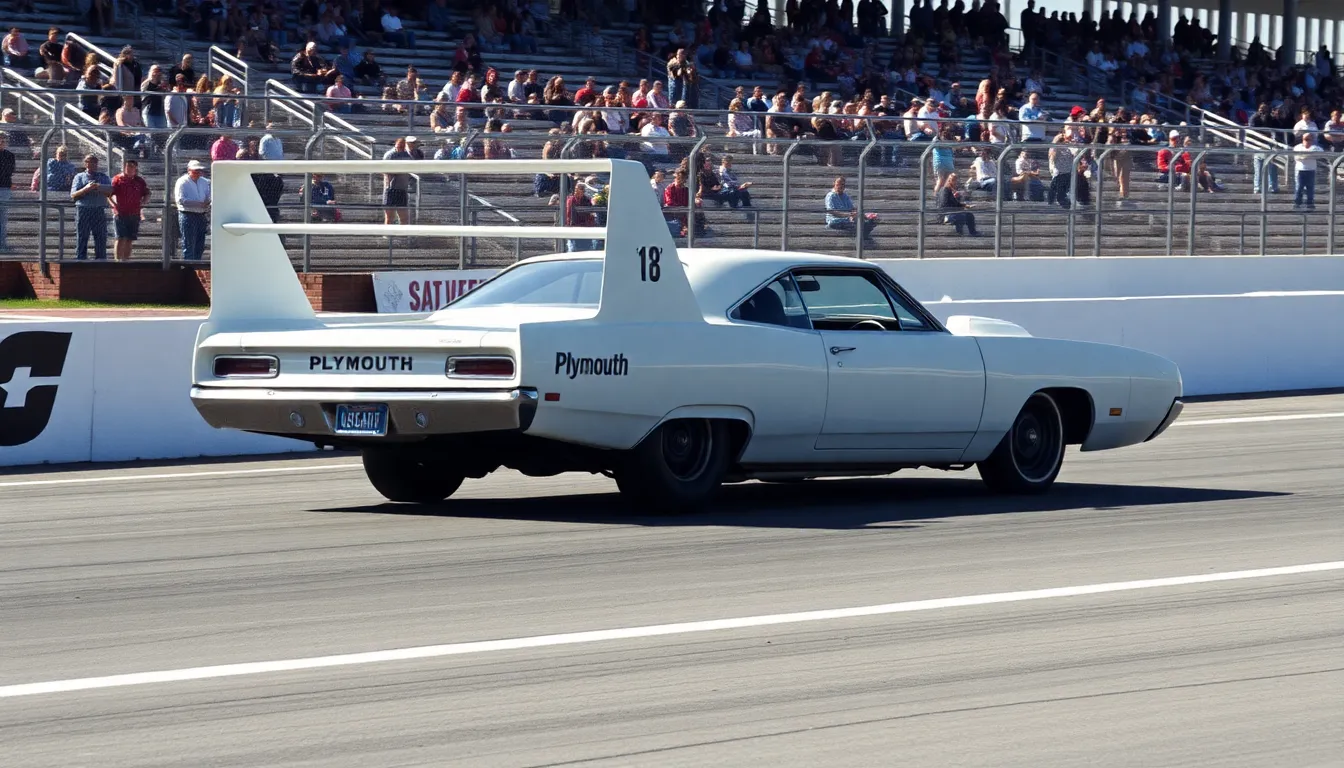
Professional racing circuits witnessed some of the most extraordinary automotive engineering achievements during the 1970s. These purpose-built machines pushed performance boundaries while capturing America’s imagination on and off the track.
Plymouth Superbird
Plymouth’s Superbird soared above NASCAR competition with its radical aerodynamic design and unmatched speed capabilities. We recognize this 1970 model as one of racing’s most distinctive vehicles, featuring its iconic 18-inch rear wing and elongated nose cone that reduced drag coefficients significantly.
Racing teams chose the Superbird for its proven track dominance, securing 21 NASCAR victories during its debut season. The vehicle’s 440 Six Pack or 426 Hemi V8 engines delivered consistent power output while maintaining reliability throughout grueling race distances. NASCAR officials eventually restricted the Superbird’s aerodynamic advantages, making it one of the last true factory racing specials.
Collectors now value original Superbirds at premium prices, with authentic race-prepared examples commanding over $300,000 at major auctions. The model’s brief production run of just 1,935 units makes it one of the rarest muscle cars ever manufactured.
Ford Torino Talladega
Ford’s Torino Talladega represented the Blue Oval’s most serious attempt at NASCAR supremacy during the late 1960s and early 1970s. We’ve documented how this aerodynamic warrior featured a lengthened nose and flush-mounted grille that improved airflow characteristics at superspeedway speeds.
Track performance proved the Talladega’s engineering excellence, with drivers achieving consistent lap times above 190 mph on NASCAR’s fastest circuits. Ford produced exactly 754 Talladegas to meet homologation requirements, making each example incredibly valuable to racing enthusiasts today.
Racing success came through careful attention to aerodynamic details, including modified front bumpers and specially designed rear spoilers. Professional teams appreciated the Talladega’s stable handling characteristics and strong powerplant options, particularly the 428 Cobra Jet V8 engine that provided reliable high-speed performance.
AMC Javelin Trans Am
AMC’s Javelin Trans Am emerged as the underdog champion that proved smaller manufacturers could compete against Detroit’s Big Three on professional racing circuits. We’ve tracked how this compact warrior earned respect through Mark Donohue’s driving skills and Roger Penske’s team management during the early 1970s.
Championship victories validated the Javelin’s competitive design, capturing both driver and manufacturer titles in Trans Am racing series. The vehicle’s shorter wheelbase and lower center of gravity provided handling advantages on road courses, where agility mattered more than straight-line speed.
Factory support from AMC included special racing packages and lightweight components that reduced overall vehicle weight by several hundred pounds. Professional racing teams appreciated the Javelin’s reliability and parts availability, factors that contributed to its success against more established competitors like the Camaro and Mustang.
Design Trends That Made 70s Cars Instantly Recognizable
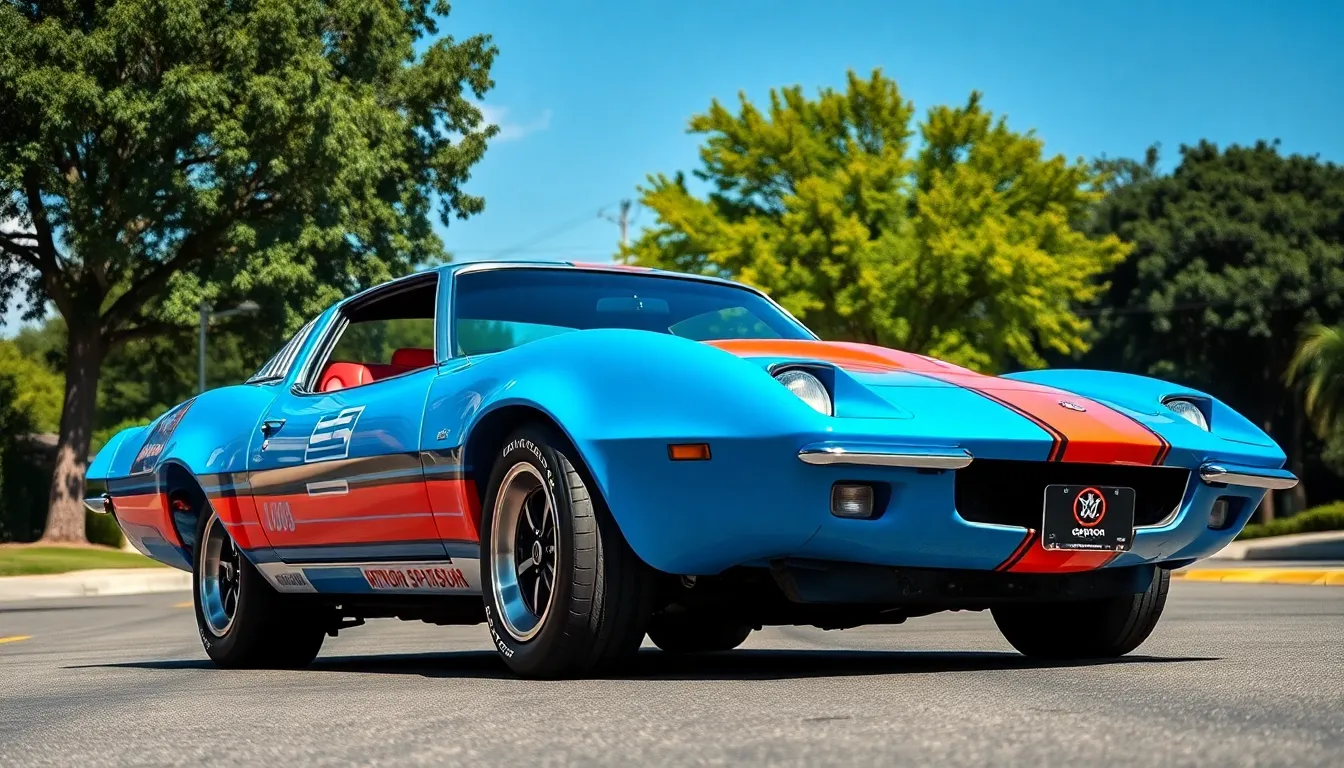
The 1970s automotive industry was defined by dramatic visual elements that made vehicles instantly identifiable from any era. These design characteristics reflected the cultural shifts and technological advances happening throughout the decade.
Bold Color Schemes and Graphics
Vibrant exterior paint options dominated 70s automotive styling like no other decade before or since. Manufacturers embraced electric blues, bright oranges, lime greens, and deep purples that made their vehicles stand out in parking lots across America. The Dodge Challenger offered High Impact Colors like Plum Crazy Purple and Go Mango Orange that became legendary among enthusiasts.
Racing stripes and graphics packages transformed ordinary cars into visual statements of performance intent. The Chevrolet Camaro Z/28 featured bold racing stripes that ran from front to rear, while the Plymouth ‘Cuda showcased side graphics that emphasized its muscular proportions. These decorative elements weren’t just cosmetic additions but served as marketing tools that communicated speed and power to potential buyers.
Two-tone paint schemes gained popularity throughout the decade as manufacturers sought ways to make their vehicles more distinctive. The Ford Pinto Squire featured wood grain vinyl that mimicked expensive station wagon styling, while luxury sedans like the Cadillac Eldorado offered contrasting roof colors that enhanced their elegant proportions.
Aerodynamic Body Styling
Sloping hoods and fastback rooflines emerged as dominant design themes as manufacturers began understanding aerodynamic principles. The Plymouth Superbird’s radical nose cone and towering rear wing represented the extreme end of aerodynamic thinking, though most production cars adopted subtler approaches to wind resistance.
Long, low profiles became the aesthetic goal for sports cars and muscle cars throughout the decade. The Chevrolet Corvette Stingray exemplified this trend with its dramatic wedge shape that tapered from a high rear deck to a low nose, creating visual drama while improving high-speed stability.
Integrated bumpers replaced the chrome appendages of previous decades as safety regulations demanded better impact protection. The 1974 Pontiac GTO featured body-colored urethane bumpers that maintained the car’s clean lines while meeting federal safety standards, setting a precedent for modern automotive design.
Distinctive Interior Features
Deep bucket seats with high bolsters became standard equipment in performance-oriented vehicles as manufacturers recognized the importance of driver support during spirited driving. The Porsche 911 Turbo featured form-fitting seats that held occupants securely while providing the comfort needed for long-distance touring.
Dashboard designs embraced bold instrumentation with large, easy-to-read gauges that emphasized the performance nature of 70s automobiles. The Datsun 240Z featured a full set of round gauges mounted in a padded dashboard that combined functionality with sporting aesthetics, influencing sports car design for decades to come.
Woodgrain trim accents appeared throughout interiors as manufacturers sought to convey luxury and sophistication to buyers. The Lincoln Continental Mark IV showcased extensive wood trim on the dashboard and door panels, while even economy cars like the Honda Civic offered woodgrain options to appeal to style-conscious consumers seeking upscale appearances in affordable packages.
Conclusion
The 1970s proved to be one of the most groundbreaking decades in automotive history. We witnessed an industry that successfully navigated unprecedented challenges while delivering vehicles that continue to capture our imagination today.
From thunderous muscle cars to practical compacts the decade’s diversity remains unmatched. These machines didn’t just transport people—they reflected America’s evolving identity and priorities during a time of important social and economic change.
Today’s collectors and enthusiasts still seek out these automotive treasures proving their lasting appeal. Whether it’s a Corvette Stingray or a Honda Civic each vehicle tells a unique story of innovation adaptation and American ingenuity.
The legacy of 70s cars continues to influence modern automotive design and culture reminding us why this decade remains a golden era for car enthusiasts worldwide.
Frequently Asked Questions
What were the most iconic muscle cars of the 1970s?
The most iconic muscle cars of the 1970s include the Dodge Challenger R/T with its powerful 426 Hemi V8 engine, the Plymouth ‘Cuda known for multiple engine options and racing heritage, and the Chevrolet Camaro Z/28 which was GM’s competitive response to the Ford Mustang. These vehicles delivered exceptional performance and became significant cultural symbols despite facing emissions regulations.
How did the oil crisis impact American car preferences in the 1970s?
The oil crisis fundamentally changed American driving habits, leading consumers to prioritize fuel efficiency over performance. This shift resulted in the rise of compact cars like the Honda Civic, Toyota Corolla, and Volkswagen Rabbit. Japanese automakers gained significant market share by offering reliable, fuel-efficient vehicles that met the new consumer demands.
Which sports cars defined the 1970s automotive landscape?
The defining sports cars of the 1970s included the Chevrolet Corvette Stingray (1970-1976 models), known for desirable features and racing heritage; the revolutionary Porsche 911 Turbo with groundbreaking turbo technology; and the Datsun 240Z, which symbolized Japanese engineering excellence and offered competitive performance that appealed to American consumers seeking pure driving passion.
What luxury sedans set new standards during the 1970s?
The luxury sedans that redefined comfort and style included the Cadillac Eldorado with its bold design and 500 cubic inch V8 engine, the Lincoln Continental Mark IV representing the pinnacle of American luxury engineering, and the Mercedes-Benz S-Class featuring groundbreaking safety innovations like the first production anti-lock braking system.
How did station wagons adapt to family needs in the 1970s?
American station wagons catered to growing families through spacious designs and practical features. The Chevrolet Caprice Estate offered impressive cargo capacity, the Ford Country Squire featured premium amenities and iconic wood grain exterior, and the Oldsmobile Vista Cruiser provided innovative panoramic skylight windows, all reflecting suburban family needs.
Which European imports gained popularity in America during the 1970s?
European imports that gained American popularity included the BMW 2002, which established the brand’s performance reputation; the Volvo 240 Series, favored for safety innovations and durability; and the Saab 99, appealing to buyers seeking unique design and engineering alternatives to conventional domestic vehicles.
How did pickup trucks evolve during the 1970s?
The 1970s saw pickup trucks transform into more capable and comfortable work vehicles. The Ford F-150 revolutionized the segment with balanced cargo capacity and maneuverability, capturing 25% market share. The Chevrolet C/K series offered robust engineering, while the Dodge D-Series provided straightforward, competitively-priced solutions for working professionals.
What design trends characterized 1970s automobiles?
Distinctive 1970s design trends included bold color schemes with vibrant paint options and racing stripes, aerodynamic body styling featuring sloping hoods and fastback rooflines, and performance-oriented interiors with deep bucket seats and bold instrumentation. These elements reflected cultural shifts and technological advancements of the transformative decade.

